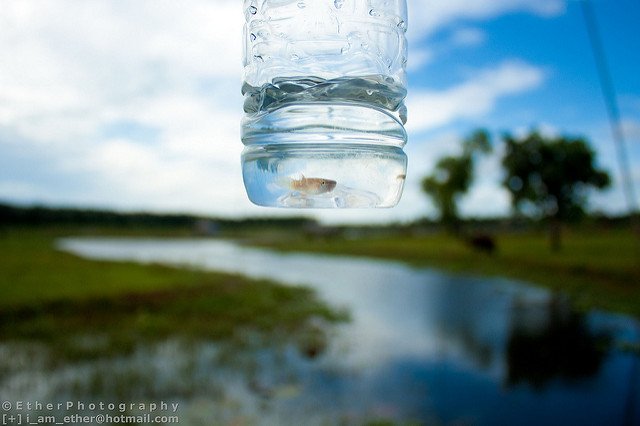There's Something in the Water
As you may recall from my intro post, my work as an attorney is focused primarily on environmental pollution. Right now, water contamination is an issue that affects everyone. I plan to post a series of articles, each one addressing a contaminant that has been the subject of recent investigations. Today, it’s PFOA.

What is PFOA?
Perfluorooctanoic acid contamination, commonly known as PFOA, has been discovered in several states across the country, including New York, Pennsylvania, Vermont, Michigan, and New Hampshire. PFOA is a synthetic chemical found in a variety of consumer and industrial products, the most familiar being Teflon. Indeed, many of you might remember the media firestorm that took place a decade or so ago after studies revealed that the popular nonstick coating used on cookware may cause adverse health effects such as cancer.Where is it found?
PFOA is a surfactant that is part of a family of substances known as perfluorinated compounds (PFCs). Surfactants are typically used during the process of making other chemicals (Teflon (PTFE), for example) due to their ability to alter surface tension. PFOA, which is both water and lipid resistant, was commonly used during manufacturing to make certain products waterproof and stain resistant. Teflon is the most popular PFOA-containing product, but it is not the only one. Things like carpet, dental floss, leathers, clothing, and even pizza boxes were made using PFOA. In addition to consumer products, it is also found in industrial products such as firefighting agents.
How did we find out it is toxic?
In 1998, a few local farmers in West Virginia sued DuPont claiming that activities at the company’s Washington Work plant were harming their cattle. They knew the site was contaminated but they didn’t know with what. It wasn’t until the discovery phase of the litigation that PFOA was identified and its harmful effects became known. At the time, PFOA was not regulated by the Environmental Protection Agency nor was it considered a hazardous substance. Ironically, the “studies” mentioned in the opening paragraph were secret medical studies performed by DuPont and 3M in the decades prior. They had known for quite some time that PFOA was harmful (at least to animals); they just didn’t bother telling anybody. So for many, many years, DuPont used the property next to the farmers’ as a landfill for PFOA-saturated sludge.

The farmers’ case ultimately led to a class action, which resulted in a historical settlement and the industry’s promise to stop using the product by 2015. One of the key terms of the DuPont settlement was the funding of a science panel tasked with monitoring the physical condition of the area’s residents from 2005-2013.
Why the recent surge in contamination?
PFOA’s newfound popularity might make it seem like the contamination is the result some recent midnight dumping but unfortunately that isn’t the case. Instead, the increase in complaints is the product of two factors: 1. New Information and 2. Legacy Contamination.

1. New Information
Until recently, we were at an information disadvantage. After the DuPont scandal, however, PFOA landed on the EPA’s next list of unregulated contaminants that have the potential for adverse health effects. As explained in an earlier post, the EPA is required to publish this list every five years. Once a contaminant is identified, resources are allocated to investigate its effects.In January 2009, the EPA issued a provisional health advisory for PFOA setting the action level at .4 micrograms per liter. By that time, the only studies assessing toxicity were on animals and although health effects were identified, the EPA considered the results to be inconclusive as applied to humans.
In 2013, the “science panel” created by the DuPont settlement finished its study. After monitoring the residents of Ohio and West Virginia for eight years, the panel concluded that there was a probable link between exposure to PFOA and the following: high cholesterol, ulcerative colitis, thyroid disease, testicular cancer, kidney cancer, and pregnancy-induced hypertension.
In May 2016, the EPA issued an official drinking water health advisory for PFOA outlining the potential links to health effects and lowered the action level from .4 to .07 micrograms. In its report, the EPA explained that PFOA withstands degradation and, as a result, is “bioaccumulative.” Bioaccumulation simply means that PFOA levels in the body tend to increase because of 1. constant or repetitive exposure and 2. the slow rate at which it’s broken down. Which makes sense--PFOA helped make products resistant to water and stains; if it was easily broken down, it wouldn’t have served its purpose.
Unfortunately, PFOA’s resistance to degradation is also the reason why PFOA levels in soil and water are increasing.

2. Legacy Contamination
Although manufacturers agreed to stop using PFOA by 2015, there is no way to recover products that have already been dispatched. Even worse, past disposal of such products in landfills has led to the contamination of soil which in turn pollutes ground water.Unfortunately, this is only the beginning for PFOA.

What can you do to be proactive?
You can start by checking out your area's Consumer Confidence Report. Each year, your water supplier is required distribute the report to residents. You can access it here: https://ofmpub.epa.gov/apex/safewater/f?p=ccr_wyl:102You can also contact your provider and ask them what pollutants they test for and what contaminants your system is vulnerable to.
Additonal Information
PFOA Health Advisory: https://www.epa.gov/sites/production/files/2016-05/documents/pfos_health_advisory_final-plain.pdf
PFCs: https://www.niehs.nih.gov/health/materials/perflourinated_chemicals_508.pdf
DuPont Case: http://www.nytimes.com/2016/01/10/magazine/the-lawyer-who-became-duponts-worst-nightmare.html
DuPont Science Panel Results: http://www.c8sciencepanel.org/
note: this post is for informational purposes only and is not intended to be legal advice or create an attorney-client relationship.
Scary stuff. With so many people dying from cancer and all other types of diseases it makes you wonder if all of the products we have been using for so many years have been killing us slowly. I believe so. And nobody cares. As long as we stay loyal consumers and keep spending money to make them rich our health means absolutely nothing to them. They simply do not care.
You hit the nail on the head, my friend. The reason we are seeing a surge in exposure cases is not because people are inherently litigious (which is what big companies argue), it is because we can finally idenitify sources and prove causation.
i started drinking only bottled water from glas bottles. no more PET for me since 4years.
you cant avoid everything, but you can try to minimize the risk
Exactly!
Yeah, I quit using teflon at home because of PFOA. I have worked as an Ecological Risk Assessor/Ecotoxicologist and as I am sure you know there are many emerging chemicals. Following your work.
Awesome! I will probably try to pick your brain sometime.
thank you posting this so long ago, it's finally coming to the surface, it even reached 8'Oclock news in the Netherlands :
http://www.eenvandaag.nl/broadcast/6149
Great post!
I was just wondering if i were a resident living in Ohio and West Virginia and if i have kidney cancer for example, which law in United states can i use to seek compensation from DuPont?
I have a post on EIA and biodiversity. https://steemit.com/nature/@coinbitgold/nature-has-no-voice-and-how-steemians-can-speak-for-them
If you have some time, I would like to hear your comments if possible! :-)
Thank you! Your quesiton brings up a very complex issue that ultimately depends on the facts. I'll give it a go, though.
To start, the compensation offered was to a specific group of residents that lived within a specified radius. In any case, the plaintiff suing for personally injuries related to toxic exposure has to prove: 1. he/she was in fact exposed and 2. that the defendant was the cause. In the DuPont case, the plaintiffs alleged that a specific activity (sludge dumping) performed by the defendant was the cause of their injuries. Both elements are usually proven by an expert.
Causation (#2) it is actually one of biggest hurdles to overcome in exposure cases. Defendant's will always argue that their activities aren't what caused the inuries and therefore they shouldn't be responsible. Such arguments will usualy take the form of: someone else did it, plaintiff has cancer because she smoked, this chemical doesn't cause those injuries, etc. However, once causation has been established, an expert would then identify the area with PFOA contamination levels above the allowable level. If you lived in this area, you would satisfy the element of exposure/injury (#1).
As for the legal theory, toxic exposure cases usually invoke what is known as tort liability. The causes of action often consist of negligence, strict liability, negligence per se, violation of state and federal statutes, etc.
So, to make a long story short, an Ohio or West Virginia resident wouldn't be able to "piggy-back" off of the earlier case because that case involved a specific activity in a specific area. If they believe their injuries are the result of other activities by DuPont, they would have to bring a new suit.
Indeed, causation is hard to prove in exposure cases. We don't know for sure if in the first place, PFOA unsafe levels can cause it but again some people are more susceptible to cancer and some don't because of genes.
Thanks for the informative and awesome reply! Good to hear from a lawyer's point of view
If I read that last line right we are all in a client attorney relationship!!!!! (don't care what it says I read what I want it to say). Very good post, just have to make light comments after reading something...... that dark. Not your post, just that it happens, the old profit vs cost to settle mentality
haha! I know, typical lawyer move adding a bunch of fine print.